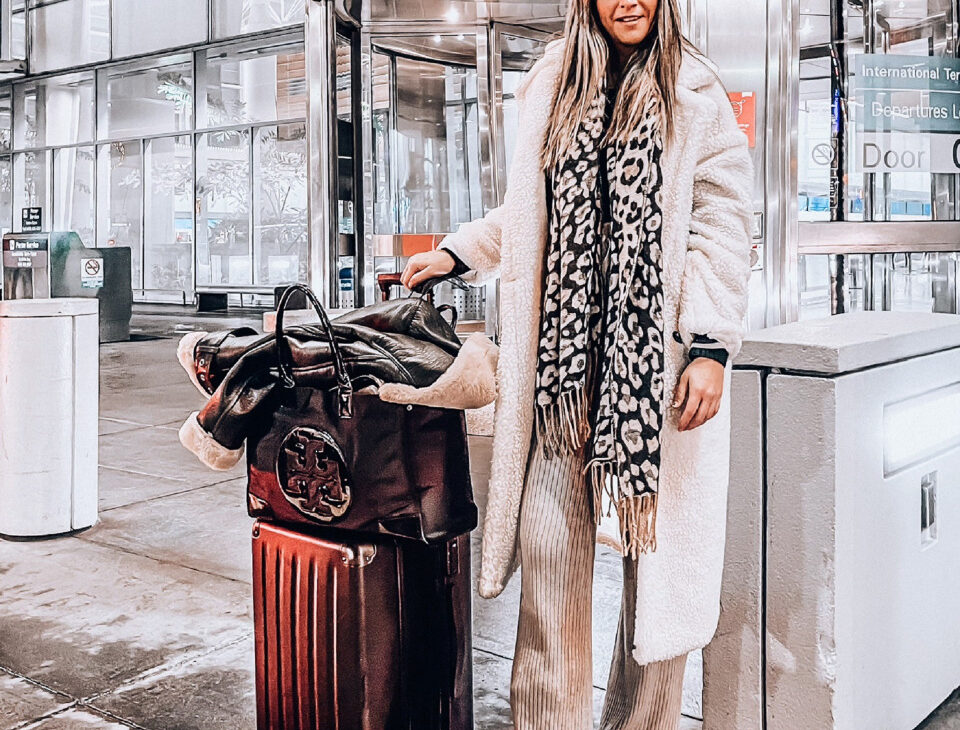10 Tips For Backpacking in Europe

Are you thinking about backpacking in Europe, but you’re afraid of the possible challenges you may find along the way? I have gathered some tips for you here that helped me a lot!
I always wanted to go backpacking in Europe, but I hated the idea of traveling alone. In December (2021), my aunt invited me to join her trip to Portugal for 20 days, but she had to cancel everything 4 days before my flight from San Francisco. With that, now I had 4 days to plan a 20-day trip ALONE. So here I want to share some things that would have been useful to know before the trip, and others that were super helpful along the way.
My trip started in Lisbon, Portugal. My flight from SF left on Christmas evening, so it cost half the normal round trip price. If you don’t mind traveling on Christmas or New Years, it’s a great way to save. Also, flights are very cheap within Europe, and traveling around gets even cheaper if you take trains or buses.
I had been to Portugal before, so I didn’t want to stay too long, and from there I flew (for only $64 dollars!) to Vienna, Austria, then to Budapest, Hungary, for the NYE, then to Oslo, where I visited a friend in Norway.
While in Norway, I decided to go North to see the Northern Lights since it was winter, and the experience was a DREAM! Then I flew back down to Munich in Germany, and ended the trip in Prague in the Czech Republic.
So here are some things to think about if you are planning to travel like I did:
1 – Big Hostels Vs. Small Hostels
Fact: staying in hostels makes everything a lot more fun. You meet other people who are doing the same thing as you, make new friends from all over the world, and end up sightseeing with them.
I stayed at the Wombat Hostel in Vienna, in Budapest and in Munich. In Prague I stayed in a smaller one called Hostel One Old Town, which gave me an interesting perspective. Wombat is a very big hostel, with many floors, so there are a lot of people coming and going all the time. When I stayed in the smaller one, with only one level of rooms, I felt more at home, you know? We all hung out in the living room together in the evenings and played games or planned something fun for the night time. So looking back, I probably would have chosen a smaller hostel everywhere, but it totally depends on what your vibe is and what you are looking for. Oh, just don’t expect anything fancy in these places. The vibe is more like college dorms. One good thing about Wombat being a big one though, is that the common areas are huge and they served a simple breakfast for about 6 Euros every morning with unlimited coffee!


2 – Currency And Purchases
In my mind, I would be able to use Euros everywhere I went. But, this is not true… When I arrived in Budapest, I found out that they do not use Euros. If you choose to, some places allow you, but their conversion ends up being higher/not accurate, so it’s not a good idea. One solution to this is to use credit cards to avoid being cheated in the conversion. Be sure to check the international transaction fees on your card though, because while one of my banks charged a percentage of the purchase as transaction fee, another one did not. In Prague and in Norway it was the same thing, no Euros. So if you don’t have a credit card you can use, make sure you exchange money when you arrive in a different country, or withdraw money from ATMs of banks. Stay away from the stand alone ATMs as their fees are higher.
3 – Ubers And Taxis
I assumed that Uber worked everywhere, but not quite. In some countries Uber’s don’t exist, so you will have to use cabs. I also found out that in many countries in Europe they use an app just like Uber that is for taxis.
In Budapest, for example, you cannot flag down a taxi, although there are many driving around, they won’t stop for you, because they come to you only through this app. The app is called Bolt and it is very widely used in Europe. So make sure you download it!
4 – SIM Card For Your Phone
You can get a pretty cheap SIM card that works all over Europe for about $20 euros. The top 2 are Vodafone and Orange, which works best. My Vodaphone one ended up not working in Prague for some reason, and while talking to some locals, I learned that Orange has the best coverage everywhere in Europe.
5 – Planning How To Get From One Country/City To Another
There is an app/website called Rome2Rio, in which you enter where you are traveling from, and your destination and it shows you all the options, like bus, train, flights, with prices, departure times, and all the trip info, so you can compare and choose the best one for your schedule and budget. And most of the time they also have links to purchase the ticket right there
6 – FlixBus
This is a great bus service to go to different countries/cities and I found it by using Rome2Rio I mentioned above. It works in almost all of Europe, the prices are really great, and they have several departures daily to most places. I paid only 30 Euros to go from Vienna to Budapest, which was a very comfortable 2h 45 min trip with WI-FI and power outlets. FlixBus is very popular in Europe, so don’t leave it for the very last minute to get your ticket or it might be sold out.
7 – Voltage and Power Outlets
I already knew that the voltage in Europe and the plugs were different from the ones here in the USA, so I was prepared! I brought the adapters for the outlets, but forgot to double check if my hair dryer was dual voltage, and ended up frying it haha. So make sure you check before you bring yours, otherwise it’s a waste of valuable space when traveling with so little on you.
8 – Packing Smart!
Traveling with only one carry-on for a long period of time is not an easy task. Pack light, but pack smart. And make sure whatever you’re bringing is absolutely necessary, and that you’re bringing clothes you can mix and match so you can put together different outfits. Also choose items that don’t take much space, or that are made of heavy fabrics.
But what if it’s really cold?! I brought ONE pair of thick, flanneled tights that I used under every pair of pants. It’s better to layer, than to bring heavy clothes. Limit yourself to 2 of each of the big stuff, like shoes and jackets, and bring more variety of tops and bottoms.
It’s important to make sure you don’t have too much luggage, because hopping from one place to another is a challenge when you are carrying too many things and you’re not familiar with the surroundings. You also don’t want to have a big suitcase/checked bag (if you’re flying) because 1, it’s a huge pain to lug that around, and 2, you waste a lot of precious time waiting for your luggage in baggage claim.
9 – Figuring Out Best Area To Stay And What To Do In Each City
Google is a great tool for sightseeing (and honestly, your best friend when traveling abroad). You can find all the best places to visit anywhere if you type “Things to do in…” and the name of the city.
When you scroll down the page and tap the map, Google has all the best sights that can be interesting to visit marked there for you. By just tapping each one, you can see a picture, a short description,and even save it! This way you can have all the places you want to visit saved on the map so you can plan your route each day.
This is also a great tool for choosing where to stay. Once you know where all the places you want to visit are located, you can then choose a hostel/hotel that is close to most of them. This usually ends up being the main area of the city (there you found it!), and the best area to stay so you can walk everywhere instead of having to travel far.
To find the hotel/hostel, you can do the same thing on google, and type “hostels in…” and the name of the city, and again, you’ll have their location and prices on the map, so you can compare and pick one in the area of the city you chose to stay based on the sights you want to visit!
10 – Paying For Public Transportation
Many countries in Europe have an “honesty-based” system – Yes, you read that right!, Which means that they trust that you have paid for your ticket when using that transportation. There is rarely someone checking whether you have paid or not. And yes, everyone pays for it! Germany, Austria and Norway are some examples.
For most trains and buses within cities, you either use apps to pay for your fare, or you have to find a station to buy a ticket. The stations are not always there though. I was getting on a bus in Norway and there was no place to buy your ticket except through the app, but I couldn’t download it on the spot. I tried to pay once I got on the bus, but there was no way to do that. In most cases, you can’t pay for your ticket once you’re already inside, so check and download the appropriate application in advance.
I didn’t know all this and rode for free a few times while trying (or going crazy) to figure out how to pay until I read online about the honesty-based system. But, be careful, because every once in a while there will be someone checking your receipt. And if they catch you, the fine is not cheap. And no, playing the tourist card doesn’t work!
Also, on some occasions you need to scan your ticket on your way out of the station. So make sure you find the appropriate way to purchase your ticket, because you might not have the same luck as I did! hahaha.
But this is all within the cities! When you are traveling longer distances by train and bus (or from country to country) there will always be someone coming to check your ticket. By bus they usually check before you get on it, and by train usually a few times during the trip.
Like I said before, always remember, Google is your best friend! Don’t know the app, the law, where to stay, the currency, or have any questions? Just Google it!
Hope this was helpful! Let me know if you have any questions!
Xx
MM












Lucia
Love the post!